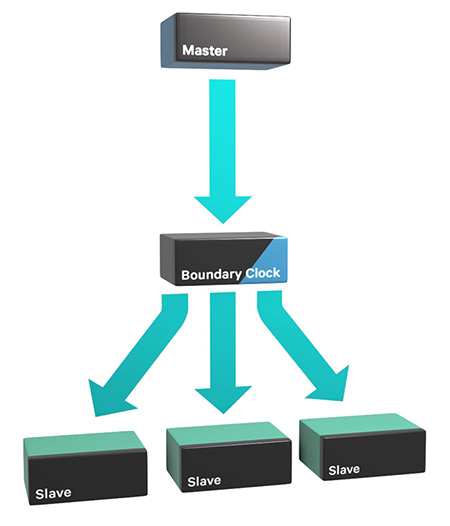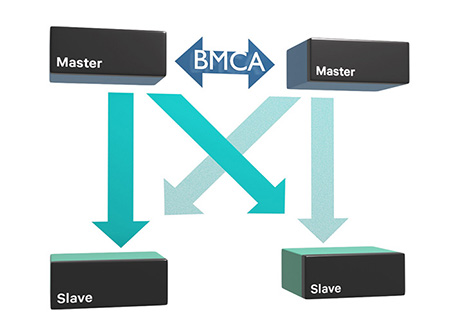
What’s The Difference Between Types Of Clocks?
Many types of clocks are used in timing, especially Precision Time Protocol or PTP (IEEE 1588). Here’s a quick guide to the basics of these clocks.
What Is A Master Clock?

The first type of clock you’ll encounter is a master clock – the main source of time on a network. Usually you’ll set this up so that it’s getting a time signal externally. GPS or another satellite network or combination is common. The master clock will then transmit this time signal across the network.
Used to: Provide time to a network
What Is A Slave Clock?
When using a master or grandmaster clock, other devices which sync to the master’s time are called slave clocks or slave devices. A slave clock is a device that syncs with the master or grandmaster clock but does not act as a source of timing. If your network is running PTP or NTP the slave clocks will take the time from the master clock, adjust to account for network lag, and sync themselves to this time.
Used when: receiving time at a device
What Is A Transparent Clock?

Transparent clocks are used to route timing messages within a network. A transparent clock (often a PTP enabled switch) allows you to timestamp the packet before it reaches a slave device, making it easier to calculate network delay. They operate in place of a normal switch, which can otherwise introduce inaccuracy when the network gets congested.
Transparent clocks also manage the ordering of packets coming from multiple sources. If the output port is busy, it will stamp each packet with an arrival and departure time to account for time spent waiting in the clock.
Used when: Ethernet timing must pass through switches
What Is A Boundary Clock?

A boundary clock in PTP is both a slave and a master clock. It will take the timing message in, adjust for delay, and then create a new master time signal to pass down the network.
This means you have a new timing packet which is still correctly synced with the master, and can reduce the number of devices the master is directly talking to. The packets are also able to resist some of the effects of distance degradation because they are reproduced from scratch. A transparent clock does not reproduce the signal in this way, but instead only adds delay information to the existing signal.
Note that a Boundary Clock can translate between signal types, and is also able to operate on more than one subnetwork. A transparent clock has neither of these abilities.
Used when: There are too many devices on a network for one master, long distances are involved, or signals need to be translated between protocols (such as PTP to IRIG-B).
What Is A Grandmaster Clock?
When using a precision timing protocol (PTP) timing network, the grandmaster clock is the main distributor of time in a multi clock network, sending time downstream to other master clocks. In the above example regarding Boundary Clocks, the master clock could also be called a grandmaster.

Sometimes more than one clock could feasibly be the grandmaster. To decide which clock takes this role, the clocks automatically use the Best Master Clock Algorithm (BMCA). This determines which clock is the better or most accurate source of time for the network.
Used to: provide the best source of time when several are available, and provide time to other clocks on the network (PTP only)
About Tekron
It’s the late nineties.
Our first clock was made in a spare room as a revolutionary design – the most cost-effective atomic accuracy clock available. Customers from NZ and overseas started lining up.
Based on this success, Tekron International Ltd was formally founded in 2002 in Wellington, New Zealand.
Many of those TCG01 units remain in service to this day in many of the largest power and utility companies worldwide. We’ve also evolved into more than just the power sector. Tekron clocks are now used in everything from feature film data security and editing to oceangoing research vessels, sports television and spacecraft development. You’ll even spot Tekron clocks in autonomous vehicles.
You can find Tekron products in over 90 countries and growing, including Antarctica.
How? It’s all about the team. We’ve gathered a unique and varied set of skills across many disciplines to become the real experts in timing, working both internally and with partners to stay at the leading edge. These days our team of experts make GPS and GLONASS Satellite Clocks, Rubidium Atomic Clocks (including Miniature Atomic Clocks-MACs) and Stratum 1 Network Time Server solutions supporting NTP, PTP, (61850), IRIG-B, 1pps, PRP and many other standards. Anywhere that precision time is required, we can help. And we’re not stopping there. Through Tekron Labs we work with our customers and the industry to keep on innovating, solving problems and creating value.









